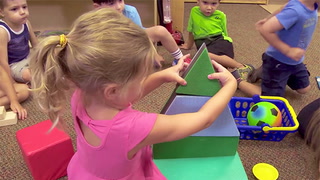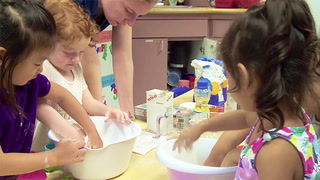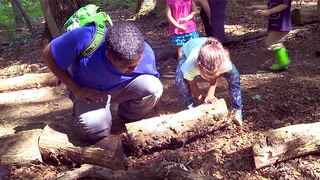STEM in Early Learning Transcript
Narrator: Young children are natural scientists, curious about the world around them and readily inclined to discover new things. While many of us think about STEM, science, technology, engineering and math, as learning that begins in elementary school, the foundation for STEM thinking and STEM processes could be nurtured and developed well before children enter kindergarten.
Play-doh Child: How about we get some more Play-doh?
Teacher: Maybe you can take some Play-doh from the bottom.
Child 1: I have-
Narrator: When we think about introducing STEM in early childhood, it is not about setting aside an extra segment of time to address STEM topics when the day is already packed full of activities. Instead, the goal is to integrate STEM processes into the daily routine and into one's early childhood curriculum.
Child 1: These are not strong enough to stand up.
Play-doh Child: We can mix three colors.
Teacher: Well, how do you think you can get them to stay?
Play-doh Child: Play-doh!
Narrator: The introduction of STEM thinking is about giving young children opportunities for active, hands-on exploration and experimentation, and building their critical thinking, prediction, and problem solving skills. Educators need not be STEM experts to offer learning experiences that keep young children's curiosity and nurture their penchant for discovery.
Teacher: Alright, who knows [inaudible 00:01:23]?
Do you guys like this one?
children: Yes!
Teacher: Yeah, that's a pretty fun book, right?
Expert Woman: Early childhood educators can use books, going to library and choosing a book, to enhance their STEM activities. Nearly every children's book you pick up ... and if you start reading through it, you'll find some inkling of a STEM experience that you could try with children.
Teacher: Meanwhile, the third pig remarked, "It's very nice, but I still don't think it's strong enough." So the third little pig searched everywhere.
"What can I find that will be better than sticks?", he wondered.
children: [crosstalk 00:02:05] Bricks.
Teacher: Bricks! Do you think that that's a better idea?
children: Yes!
Child 1: He's the smartest pig!
Teacher: He's the smartest pig?
Child 1: Because it's strong.
Teacher: We read "The Three Little Pigs" today because it's a really good story about how the building process works and what makes a good house, what are good engineering ideas ... so we read that for the kids so that they could kind of jump off of that and decide how they wanted to build their house, with what materials.
"Little pigs, little pigs, let me in!"
"NO!", they shouted.
What'd they say?
children: Not by the hair of my chinny chin chin!
Teacher: "Then I'll huff, and I'll puff, and I'll blow your house down!"
Right? But did that work?
children: No.
Teacher: No, so he tried again.
In today's activity we've looked at different structures and how they were being built. We also talked about the structures that the kids live in, what they're made out of ... brick, wood, stone. And then we brought it all together in an activity where they could make their own houses and see what materials they would use. We really did all of this to bring it back to STEM and bring it back to engineering so that the kids could get their own hands-on experience.
What do you think that the house needs?
children: Bricks.
Teacher: Bricks? What else do you think it needs?
children: Straw. [crosstalk 00:03:22] Wood.
Teacher: Wood?
children: [crosstalk 00:03:24] Sand.
Teacher: Maybe sand?
Expert Woman: The houses are all going to look different, some of them are going to collapse, but that's part of the scientific method. Sometimes when something fails, it's not a bad thing.
You want them to go back and try again, and try again, and that's what we really want children to understand. If something doesn't work the first time, it's not a big deal. It means we're going to learn a lot more by going back and figuring out what did not work and then going and making some changes.
Teacher: Juliana, how do you think you can make these stronger so they don't fall down?
Play-doh Child: I know! We can make some more Play-doh!
Teacher: We love having the kids work in teams in our classroom just so they can build those interpersonal skills and learn how to work together. It really helps them when they get stuck, they don't know what they're doing or how to build a house, they can ask their friend for advice or they can see what their friend is doing and kind of build off on that.
Play-doh Child: What about we all build together?
Child 1: I'm building like this.
Play-doh Child: I can't open up this blue Play-doh!
Teacher: We just observe them and just watch and ask them open-ended questions, seeing, what is their thinking process? Because that's really what we want to see. We want to see the process, not the end product. So we want to see how they're thinking through everything.
children: [crosstalk 00:04:48]
Teacher: Yeah?
children: It can't even go down like this ... [crosstalk 00:04:59]
Teacher: You've got to figure out how to stick it on your house.
Expert Woman: When doing an activity like "The Three Little Pigs", and children spend a lot of time building a house and they're excited to, "Look what I've made!". And they want everybody to see what they've made. They may not want to do the next part which I find extremely exciting, is to blow it down and see whether it stands, so, if a child doesn't want it to be blown down, we leave it.
Or you can take photographs of it, to allow them keep the picture of their house, respect the children's wishes.
Teacher: So, the Big Bad Wolf said, "I'll huff and I'll puff, and I'll blow your house down!"
children: [crosstalk 00:05:39] I'll huff and I'll puff, and I'll blow your house down!
Teacher: Try to blow it down! Did it fall over?
children: [crosstalk 00:05:49] Yes! (excited shrieking)














2 Comments
Dominique Jackson Aug 9, 2020 9:48pm
Mahmoud Alweher May 5, 2018 7:05am